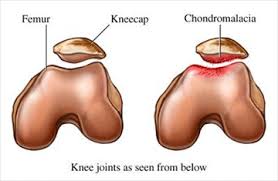Chondromalacia patellae is a subgroup of conditions that cause kneecap pain. These conditions fall under the Patellofemoral Pain Syndrome conditions.
What causes chondromalacia patellae?
Your kneecap normally resides over the front of your knee joint. When you bend your knee, the backside of your kneecap glides over the cartilage of your femur, or thigh bone, at the knee. Tendons and ligaments attach your kneecap to your shinbone and thigh muscle. When any of these components fails to move properly, it can cause your kneecap to rub up against your thigh bone. This abnormal rubbing can lead to deterioration in the patella, resulting in chondromalacia patellae, or runner’s knee.
Improper kneecap movement may result from:
- poor alignment due to a congenital condition
- weak hamstrings and quadriceps (the muscles in the back and front of your thighs, respectively)
- muscle imbalance between the adductors and abductors (the muscles on the outside and inside of your thighs)
- repeated stress to your knee joints, such as from running, skiing, or jumping
- a direct blow or trauma to your kneecap
Risk factors:
Risk Factors for Chondromalacia patella
Age:
Adolescents and young adults are at high risk as during growth spurts, the muscles and bones develop rapidly which may cause short term muscle imbalances.
Flat Feet:
Flat feet puts higher stress on knee joints.
Trauma:
A prior injury like dislocation or subluxation of patella can increase risk of chondromalacia patella.
Chronic friction between the patella and femoral groove can also result in this.
Activity:
High-activity level or that places pressure on your knee joints, this can increase the risk for knee problems.
Knee Pathologies:
Inflammation as in arthritis can prevent the kneecap from functioning properly. Other conditions of knee which can cause chondromalacia patella is patella alta [high riding patella] quadriceps imbalance, weak hamstrings, congenital abnormailites, patellar maltracking, synovial plicae, tight iliotibial band, neuromas, bursitis etc.
Overuse:
Persons engaging in soccer, gymnastics, cycling, rowing, tennis, ballet, basketball, volleyball, running, combat sports, snowboarding, skateboarding and even swimming are at increased risk.






